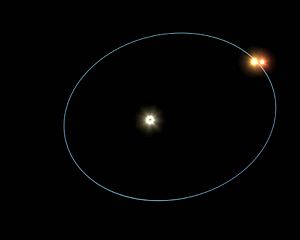Star system facts for kids
A star system is a group of stars that orbit each other. They are held together by the force of gravity. When there are many stars held together by gravity, it's usually called a star cluster. It's important not to confuse star systems with planetary systems, which include planets and other objects orbiting a star.
A star system with two stars is called a binary star system. These two stars orbit around a shared center point. If nothing else disturbs them, they can orbit each other forever. Some examples of binary star systems are Sirius and Procyon. Another one, Cygnus X-1, might have a star orbiting a black hole.
Multiple Star Systems
Star systems can have more than two stars. These stars are all connected by gravity. They might be close together or quite far apart.
Most multiple star systems have three stars. These are called triple star systems. Systems with four or more stars are less common. For example, out of many known multiple star systems, most are triple.
One interesting system has five stars! It's called 1SWASP J093010.78+533859.5. This system has two pairs of binary stars. One of these pairs also has a small third star orbiting it. The two main pairs are very far apart, even further than Pluto is from our Sun. The stars within each pair are very close. In one pair, the stars are so close they are actually touching! Their outer gases mix together. This is called a contact binary. Scientists believe all five stars are connected by gravity in one big system. They think these stars formed from a single cloud of gas and dust a very long time ago.
Some multiple star systems are very stable. This means their orbits are predictable and don't change much. Other systems can be more chaotic, especially when they are young.
Images for kids
-
Sirius A (center), with its white dwarf companion, Sirius B (lower left) taken by the Hubble Space Telescope.
See also
 In Spanish: Sistema estelar para niños
In Spanish: Sistema estelar para niños










